Mood disorders
The section examines the proportion of individuals aged 12 years and over that reported that they have a mood disorder such as depression, bipolar disorder, mania, or dysthymia. These are long-term health conditions that are expected to last or have already lasted 6 months or more and that have been diagnosed by a health professional.
Moods disorder by geographic area
Key findings:
- In 2015/16, survey results indicated that 10% of individuals aged 12 years and older in Sudbury and districts had been diagnosed with a mood disorder by a health care professional.
- The prevalence rate of mood disorders in Sudbury and districts is similar to that reported in northeastern Ontario and Ontario overall.
- Between 2007/08 and 2013/14, the prevalence rate of mood disorders in Sudbury and districts has not varied significantly.
Notes:
- Rates are age-standardized using the 2011 Canadian population.
- Rates are for the population aged 12 years and older.
- Data source: Canadian Community Health Survey (CCHS), 2007 to 2016, Statistics Canada, Share File, Ontario Ministry of Health and Long-Term Care.
Figure: Age-standardized prevalence rate, mood disorders, by year and geographic area, ages 12+, 2007/08 to 2013/14
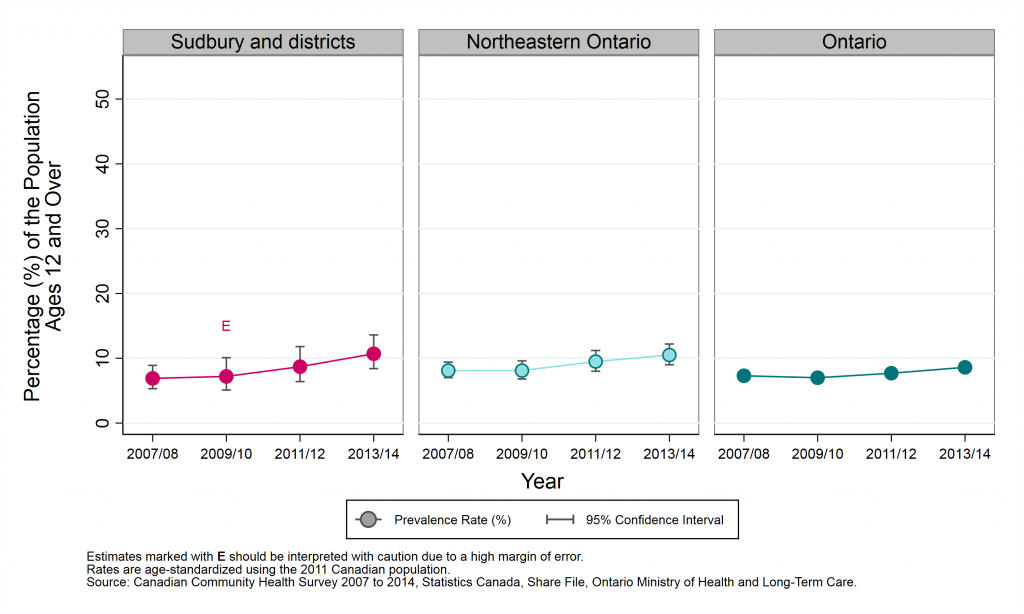
Table: Age-standardized prevalence rate, mood disorders, by year and geographic area, ages 15+, 2007/08 to 2013/14
| Geographic Region | Prevalence Rate, 2007 to 2008 | Prevalence Rate, 2009 to 2010 | Prevalence Rate, 2011 to 2012 | Prevalence Rate, 2013 to 2014 |
|---|---|---|---|---|
| Sudbury and districts | 6.9% (CI: 5.3% to 8.9%) | 7.2% E (CI: 5.1% to 10.1%) | 8.7% (CI: 6.4% to 11.8%) | 10.7% (CI: 8.4% to 13.6%) |
| Northeastern Ontario | 8.1% (CI: 7.0% to 9.4%) | 8.1% (CI: 6.8% to 9.6%) | 9.5% (CI: 8.0% to 11.2%) | 10.5% (CI: 9.0% to 12.2%) |
| Ontario | 7.3% (CI: 6.9% to 7.7%) | 7.0% (CI: 6.6% to 7.4%) | 7.7% (CI: 7.2% to 8.2%) | 8.6% (CI: 8.1% to 9.1%) |
Mood disorders by sex
Key findings:
- Between 2011 and 2014, survey results indicated that the prevalence rate of mood disorders in males in Sudbury and districts is lower than that in females.
- Between 2007 to 2010 and 2011 to 2014, the rate of mood disorders in Sudbury and districts has not varied significantly in either males or females.
Notes:
- Rates are age-standardized using the 2011 Canadian population.
- Rates are for the population aged 12 years and older.
- Data source: Canadian Community Health Survey (CCHS), 2007 to 2014, Statistics Canada, Share File, Ontario Ministry of Health and Long-Term Care.
Figure: Age-standardized prevalence rate, mood disorders, by year and sex, ages 12+, 2007 to 2010 and 2011 to 2014
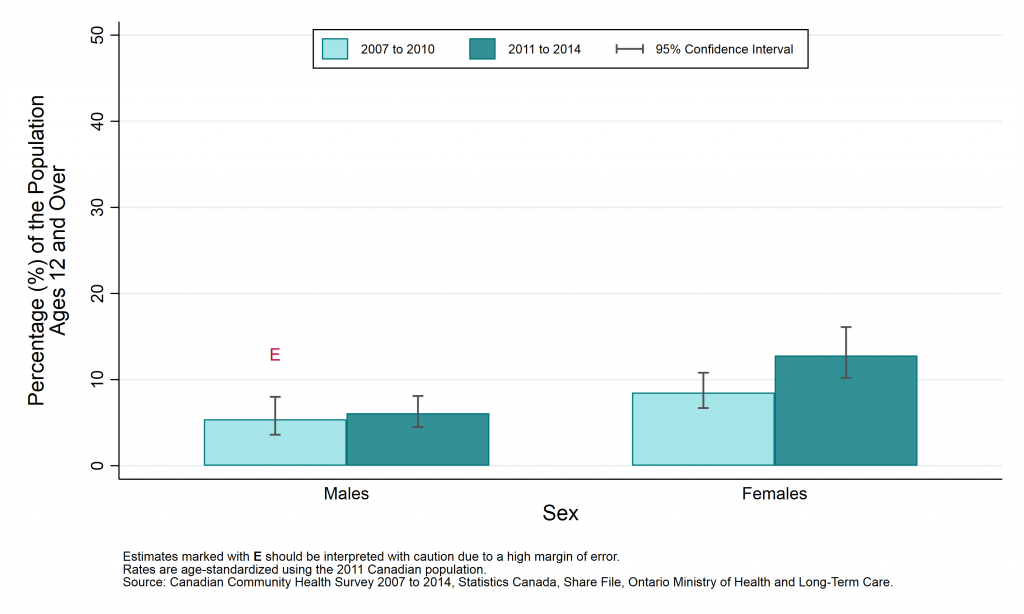
Table: Age-standardized prevalence rate, mood disorders, by year and sex, ages 12+, 2007 to 2010 and 2011 to 2014
Note: Estimates marked with E should be interpreted with caution due to high margin of error.
| Sex | Prevalence Rate, 2007 to 2010 | Prevalence Rate, 2011 to 2014 |
|---|---|---|
| Males | 5.4% E (CI: 3.6% to 8.0%) | 6.1% (CI: 4.5% to 8.1%) |
| Females | 8.5% (CI: 6.7% to 10.8%) | 12.8% (CI: 10.2% to 16.1%) |
Mood disorders by age group
Key findings:
- Between 2011 and 2014, survey results indicated that the prevalence rate of mood disorders was similar among different age groups in Sudbury and districts.
- Between 2007 to 2010 and 2011 to 2014, the rate of mood disorders in Sudbury and districts has not varied significantly in any of the age groups.
Notes:
- Rates are for the population aged 12 years and older.
- Data source: Canadian Community Health Survey (CCHS), 2007 to 2014, Statistics Canada, Share File, Ontario Ministry of Health and Long-Term Care.
Figure: Prevalence rate, mood disorders, by year and age group, ages 12+, 2007 to 2010 and 2011 to 2014
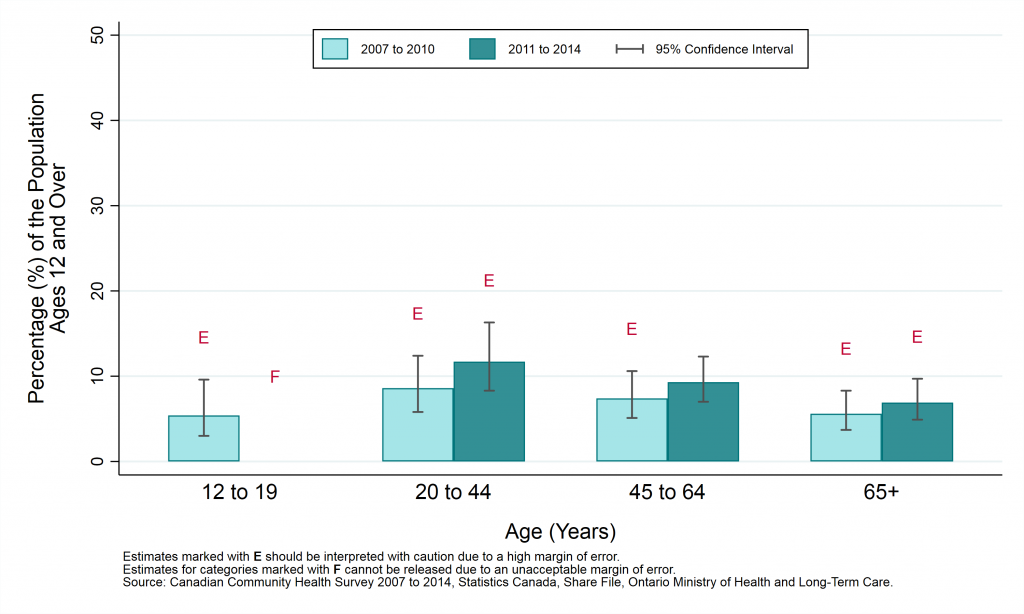
Table: Prevalence rate, mood disorders, by year and age group, ages 12+, 2007 to 2010 and 2011 to 2014
Note: Estimates marked with E should be interpreted with caution due to high margin of error. Estimates for categories marked with F cannot be released due to an unacceptable margin of error.
| Age (Years) | Prevalence Rate, 2007 to 2010 | Prevalence Rate, 2011 to 2014 |
|---|---|---|
| 12 to 19 | 5.4% E (CI: 3.0% to 9.6%) | F |
| 20 to 44 | 8.6% E (CI: 5.8% to 12.4%) | 11.7% E (CI: 8.3% to 16.3%) |
| 45 to 64 | 7.4% E (CI: 5.1% to 10.6%) | 9.3% (CI: 7.0% to 12.3%) |
| 65+ | 5.6% E (CI: 3.7% to 8.3%) | 6.9% E (CI: 4.9% to 9.7%) |
Mood disorders by household income
Key findings:
- Between 2011 and 2014, survey results indicated that the prevalence rate of mood disorders was highest among individuals in the lowest income quintile compared to individuals in other income groups in Sudbury and districts.
- Between 2007 to 2010 and 2011 to 2014, the rate of mood disorders in Sudbury and districts has not varied significantly in any of the household income quintiles.
Notes:
- In this analysis, individuals are divided into “income quintiles” or 5 groups of roughly equal size based on their reported household income. The groups are ranked, so that Quintile 1 represents the 20% of the population with the lowest incomes, and Quintile 5 represents the 20% with the highest incomes.
- Rates are age-standardized using the 2011 Canadian population.
- Rates are for the population aged 12 years and older.
- Data source: Canadian Community Health Survey (CCHS), 2007 to 2014, Statistics Canada, Share File, Ontario Ministry of Health and Long-Term Care.
Figure: Prevalence rate, mood disorders, by year and household income, ages 12+, 2007 to 2010 and 2011 to 2014
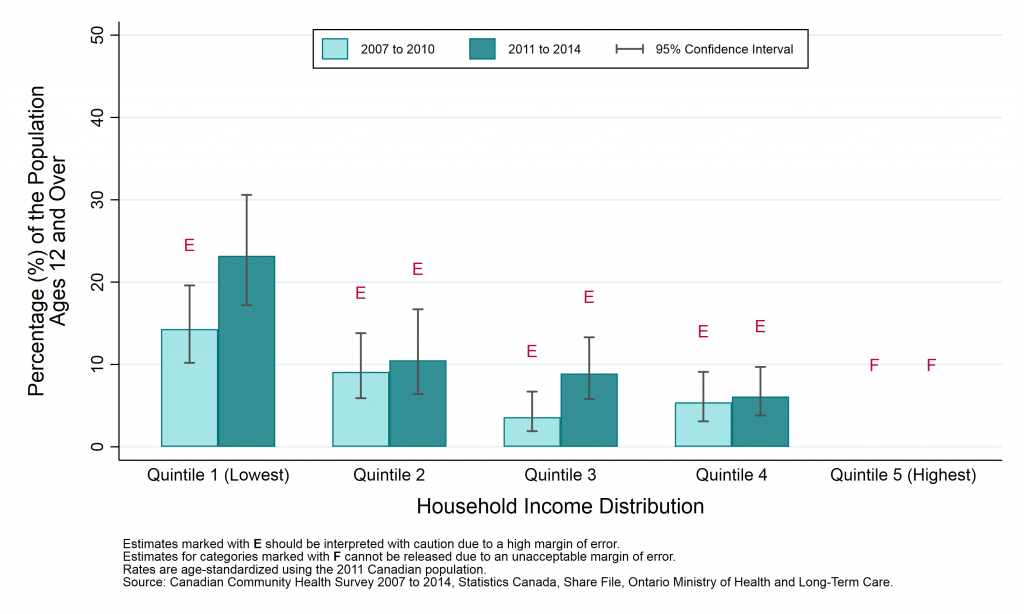
Table: Prevalence rate, mood disorders, by year and household income, ages 12+, 2007 to 2010 and 2011 to 2014
Note: Estimates marked with E should be interpreted with caution due to high margin of error. Estimates for categories marked with F cannot be released due to an unacceptable margin of error.
| Household Income Distribution | Prevalence Rate, 2007 to 2010 | Prevalence Rate, 2011 to 2014 |
|---|---|---|
| Quintile 1 (Lowest) | 14.3% E (CI: 10.2% to 19.6%) | 23.2% (CI: 17.2% to 30.6%) |
| Quintile 2 | 9.1% E (CI: 5.9% to 13.8%) | 10.5% E (CI: 6.4% to 16.7%) |
| Quintile 3 | 3.6% E (CI: 1.9% to 6.7%) | 8.9% E (CI: 5.8% to 13.3%) |
| Quintile 4 | 5.4% E (CI: 3.1% to 9.1%) | 6.1% E (CI: 3.8% to 9.7%) |
| Quintile 5 (Highest) | F | F |
Mood disorders by education
Key findings:
- Between 2011 and 2014, survey results indicated that the prevalence rate of mood disorders was not statistically different among education level groups in Sudbury and districts.
- Between 2007 to 2010 and 2011 to 2014, the rate of mood disorders in Sudbury and districts has not varied significantly in any of the education level groups.
Notes:
- Rates are age-standardized using the 2011 Canadian population.
- Rates are for the population aged 12 years and older.
- Data source: Canadian Community Health Survey (CCHS), 2007 to 2014, Statistics Canada, Share File, Ontario Ministry of Health and Long-Term Care.
Figure: Prevalence rate, mood disorders, by year and education levels, ages 12+, 2007 to 2010 and 2011 to 2014
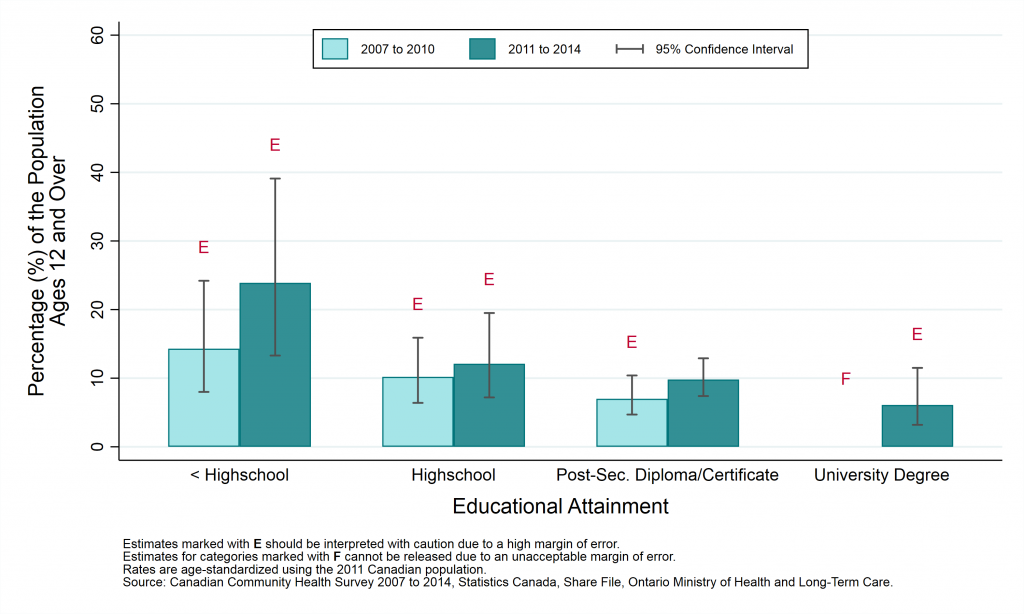
Table: Prevalence rate, mood disorders, by year and education, ages 12+, 2007 to 2010 and 2011 to 2014
Note: Estimates marked with E should be interpreted with caution due to high margin of error. Estimates for categories marked with F cannot be released due to an unacceptable margin of error.
| Education | Prevalence Rate, 2007 to 2010 | Prevalence Rate, 2011 to 2014 |
|---|---|---|
| < Highschool Diploma | 14.3% E (CI: 8.0% to 24.2%) | 23.9% E (CI: 13.3% to 39.1%) |
| Highschool Diploma | 10.2% E (CI: 6.4% to 15.9%) | 12.1% E (CI: 7.2% to 19.5%) |
| Trade, College or University Diploma or Certificate | 7.0% E (CI: 4.7% to 10.4%) | 9.8% (CI: 7.4% to 12.9%) |
| University Degree | F | 6.1% E (CI: 3.2% to 11.5%) |
Mood disorders by first official language spoken
Key findings:
- Between 2011 and 2014, the prevalence rate of mood disorders was not statistically different between official language groups in Sudbury and districts.
- Between 2007 to 2010 and 2011 to 2014, the rate of mood disorders did not vary significantly among either official language group.
Notes:
- Canada’s official languages are French and English. An individual’s “first official language spoken” is determined using their answers to a number of questions about the languages they speak. A small percentage of people are classified as having both French and English as their “first” official language spoken. Such individuals are included here as French. People speaking neither French nor English are excluded from this analysis.
- Rates are age-standardized using the 2011 Canadian population.
- Rates are for the population aged 12 years and older.
- Data source: Canadian Community Health Survey (CCHS), 2007 to 2014, Statistics Canada, Share File, Ontario Ministry of Health and Long-Term Care.
Figure: Prevalence rate, mood disorders, by year and first official language spoken, ages 12+, 2007 to 2010 and 2011 to 2014
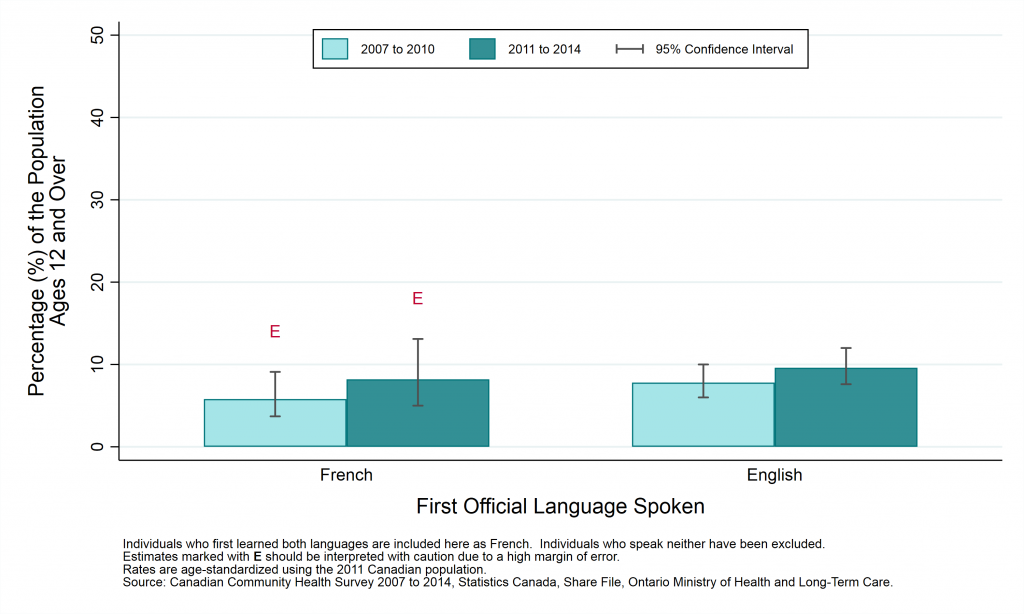
Table: Prevalence rate, mood disorders, by year and first official language spoken, ages 12+, 2007 to 2010 and 2011 to 2014
Note: Estimates marked with E should be interpreted with caution due to high margin of error.
| First Official Language Spoken | Prevalence Rate, 2007 to 2010 | Prevalence Rate, 2011 to 2014 |
|---|---|---|
| French | 5.8% E (CI: 3.7% to 9.1%) | 8.2% E (CI: 5.0% to 13.1%) |
| English | 7.8% (CI: 6.0% to 10.0%) | 9.6% (CI: 7.6% to 12.0%) |
This item was last modified on July 3, 2019
